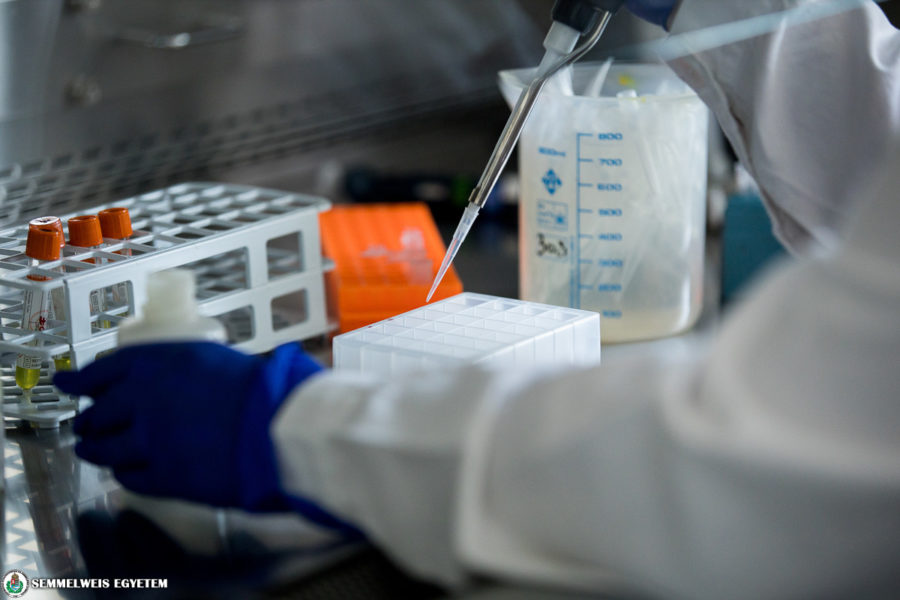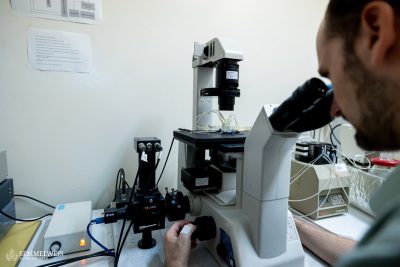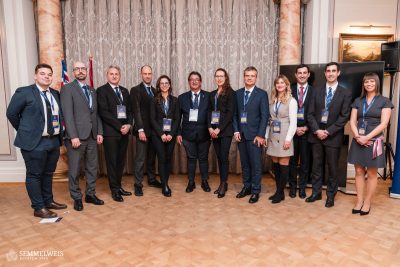The aim of the project “Live Longer” was to improve patients’ quality of life and increase their life expectancy through a Hungarian network of basic and clinical research with the approach of translational medicine. On the occasion of the closing conference the representatives of the University of Szeged, the University of Debrecen, the University of Pécs and Semmelweis University presented the results achieved during the 3-year-long projects. In his presentation Dr. Gábor Varga, Head of the Department of Oral Biology at Semmelweis University highlighted the successful cooperation of universities and how important it is to work together in similar projects in the future.
The project (EFOP-3.6.2-16-2017-00006 LIVE LONGER), which lasted 36 months, between 1 September 2017 and 31 August 31 2020, focused on the development of modern medical diagnostic treatments and therapies from a translational approach. These projects aimed to improve the patients’ quality of life and to increase their life expectancy from the laboratory to the sickbed. The joint project primarily focused on the treatment of gastrointestinal, cardiac, vascular diseases and diseases of musculo-skeletal origin. The University of Szeged, the University of Debrecen, the University of Pécs and Semmelweis University submitted the grant application in cooperation, as a consortium, and in their projects they focused mainly on the synergies realized among the universities, and on the development of their relationship system.
“The involvement of young researchers, PhD students and medical students; the mastering of new research methods; joining international research projects and knowledge transfer were considered especially important”, emphasized Dr. Zoltán Rakonczay, department head and professor at the Department of Patophysiology of the University of Szeged, the professional leader of the project.
At the online event held on 16 November, the representatives of the four medical universities introduced their research results and Anikó Zsigmond, project manager also held a presentation on the evaluation of the project. On behalf of Semmelweis University, Dr. Gábor Varga, head of the Department of Oral Biology evaluated the joint project. According to him, the institutions managed to reach all the targeted goals, and the development of human resources and research capacities, international involvement, the reinforcement of international research collaborations and research projects in the area of gastroenterology were successfully realized.
“The main task of Semmelweis University was to carry out technology- and knowledge transfer on a project level, as well its coordination among the consortial partners. Our institution was provided with a grant of 117 million HUF. Scientific research needs resources and outstanding results need collaboration.”, pointed out Dr. Gábor Varga.
 In his presentation, he talked about the results of certain projects in details, which were carried out in the framework of the tender. He considers the research related to hydrogen carbonate led by Dr. Ákos Zsembery, associate professor (Semmelweis University, Department of Oral Biology) and in cooperation with Mária Deli (University of Szeged, Biological Research Center, Szeged) and Zsuzsanna Helyes (University of Pécs) was remarkably promising.
In his presentation, he talked about the results of certain projects in details, which were carried out in the framework of the tender. He considers the research related to hydrogen carbonate led by Dr. Ákos Zsembery, associate professor (Semmelweis University, Department of Oral Biology) and in cooperation with Mária Deli (University of Szeged, Biological Research Center, Szeged) and Zsuzsanna Helyes (University of Pécs) was remarkably promising.
“The results of these projects may lead to the development of new therapies in the treatment of chronic pulmonary diseases. Cystic fibrosis is the disease of the ion channel, which is one of the most common genetic disorders concerning the Caucasian population: the extremely serious inflammatory disease often ends with a fatal outcome and there is no direct treatment available yet.”, Dr. Varga explained.
In the course of the disease, in the absence of the CFTR channel, fluid secretion decreases on the functional surface of the lungs, which is normally covered in dilute, neutral fluid, thus the cells with cilia and flagella are not capable of expelling the microorganisms from the lungs. In parallel with the acidification of the surfaces, the separated mucin greatly increases the viscosity of the biofilm covering the surfaces, which may result in the reproduction of bacteria and the emergence of an inflammation. This way, the functional capacity of the lungs is remarkably reduced, until the organ will not be capable of absorbing enough oxygen and releasing carbon dioxide..
“If hydrogen carbonate is applied to the surface of the lungs, it will facilitate proper fluid separation and retention on the surface, as well as it will prevent the growth of bacteria and the formation of abnormal biofilm. Based on the results, bicarbonate may be a part of our innate immunity, and its application may provide support in the treatment of not only cystic fibrosis, but other chronic pulmonary diseases as well.”, Dr. Gábor Varga concluded.
Semmelweis University in cooperation with the University of Pécs and the University of Szeged managed to reach significant results related to the role of pH regulation in the formation of tooth enamel. Acid-base balance is essential in several organs of the human body. Saliva, the thinnest fluid in our body, and tooth enamel, the hardest tissue, are produced via very similar processes, and the neutralization of the released acid is essential in both cases. When we drink an acidic liquid, such as orange juice, it immediately starts salivation, which is important, because the activating salivary grands produce hydrogen carbonate, and this neutralizes the acidity of orange juice. If it did not do so, the acid of the juice would erode the mucous membranes. This process is of key importance in case of tooth enamel formation as well, as the formation of hydroxyl-apatite crystals building up the enamel, relases a lot of acid.
“The details of this process are not well known, but regarding the examination and modeling of the mechanism, the research group of Semmelweis University is one of the best in the world. The novelty of their research results in this field is proven by the fact that they have wone the grant of one of the American National Institute of Health, National Institute of Dental and Craniofacial Research (NIH NIDCR), which is one of the world’s most prominent research support systems.”, highlighted Dr. Varga.
 The department head also presented the project of Semmelweis University done in cooperation with the University of Pécs, related to the research of saliva diagnostic opportunities of COVID-19. According to Dr. Varga, this project is a perfect example of the collaboration between institutions and translational approach. The project began with an in-silico, or simulation research, which studied previous publications on the appearance of virus in human saliva. In the later stages of the project Semmelweis University’s Department of Laboratory Medicine, the Department of Otorhinolaryngology, Head and Neck Surgery and the Department of Pulmonology were involved as well. The essence of the research is that the collection of saliva may be a quicker and simpler non-invasive method as opposed to nasal and pharyngeal swabs, yet PCR tests are able to detect COVID-19 infection with similar accuracy in both cases. There is a detailed presentation about this project in a previous article.
The department head also presented the project of Semmelweis University done in cooperation with the University of Pécs, related to the research of saliva diagnostic opportunities of COVID-19. According to Dr. Varga, this project is a perfect example of the collaboration between institutions and translational approach. The project began with an in-silico, or simulation research, which studied previous publications on the appearance of virus in human saliva. In the later stages of the project Semmelweis University’s Department of Laboratory Medicine, the Department of Otorhinolaryngology, Head and Neck Surgery and the Department of Pulmonology were involved as well. The essence of the research is that the collection of saliva may be a quicker and simpler non-invasive method as opposed to nasal and pharyngeal swabs, yet PCR tests are able to detect COVID-19 infection with similar accuracy in both cases. There is a detailed presentation about this project in a previous article.
“In the framework of the project, an international conference was held at Semmelweis University with the cooperation of the four universities in 2018 with 126 registered participants, 3 foreign presenters and 9 young foreign participants, 65 presentations and 6 practical, interactive courses. In the framework of the grant application, several meta-analyses were carried out, in cluding the ossification-promoting effect of the sandblasting of medical implant surfaces or the effects of chlorine dioxide in oral hygiene. Significant research projects were carried out in collaboration with the University of Pécs in the field of regenerative therapeutic procedures.
Dr. Gábor Varga highlighted two publications dealing with stem cells and the processes within the human body that deal with generating stem cells and facilitating their functioning: one of the publications focuses on bone regeneration, and the other on the renewal of dental tissues.
Within the framework of the joint project, Semmelweis University produced 34 in-extenso publications and 55 conference abstracts and 4 people received a PhD degree.
“No matter how outstanding staff and research potential the university has, excellent results can only be reached in collaboration with other institutions, both within Hungary and on an international level. We were able to unite our human resources and managed to build international relations as well. This has allowed us to apply for international grants, which would have been unavailable to us earlier. The joint project has proven that cooperation brings success”, pointed out Dr. Varga.
Ádám Szabó
Photo: Attila Kovács – Semmelweis University (photos taken previously)
Translation: Katalin Illés-Romhányi


